Search
- Page Path
-
- HOME
- Search
- Review Article
- NLRP3 inflammasome: A key player in neonatal brain injury
- Cagla Kiser, Ilkcan Ercan, Defne Engur, Sermin Genc
-
Among neonates, hypoxic-ischemic encephalopathy is the most significant cause of mortality and hypoxia-ischemia is among the leading causes of brain damage. The microglia are primary mediators of neuroinflammation. NOD-like receptor family pyrin domain containing 3 (NLRP3) inflammasome activation is the first line of defense in the central nervous system. Numerous studies have shown that the NLRP3 inflammasome is activated and... -
DOI: https://doi.org/10.3345/cep.2024.01935 [Accepted]
- Original Article
- Association between macrophage migration inhibitory factor gene and growth differentiation factor 15 gene polymorphisms and circulating levels with respiratory distress syndrome among preterm neonates
- Ali Helmi Bakri, Mohammed H. Hassan, Khaled Abdalla Abd-Elbaseer, Mahmoud Abo -Alhassan Sayed, Ahmed Alamir Mahmoud Abdallah, Eman Ahmed Abd-Elmawgood
-
Background: In preterm newborns, neonatal respiratory distress syndrome (RDS) is among the main causes of respiratory failure and mortality. However, the effect of macrophage migration inhibitory factor (MIF) on neonatal developmental lung disease is not well documented in the literature. Moreover, little is known about the effects of growth differentiation factor-15 (GDF-15) on lung maturity in preterm infants.
Purpose: To evaluate... -
DOI: https://doi.org/10.3345/cep.2025.00416 [Accepted]
- Role of microRNA-498 and microRNA-410 in neonatal hypoxic ischemic encephalopathy
- Eman Salah Eldeen Arafat, Hasnaa Hesham Abotaleb, Dina Abdel Razek Midan, Abdel Hamid Abdo Ismail, Zeinab Abouzouna
-
Background: Neonatal asphyxia is the primary cause of hypoxic-ischemic encephalopathy (HIE), a condition characterized by hypoxic and ischemic brain damage. A class of short noncoding RNAs known as microRNAs (miRNAs) have significant regulatory functions, can function as diagnostic and developmental indicators of diseases, and are involved in disease pathophysiology.
Purpose: To study the role of microRNA-410 and microRNA-498 in neonatal HIE... -
DOI: https://doi.org/10.3345/cep.2024.01669 [Accepted]
- Characterization of gut microbiota in very low birth weight infants with versus without bronchopulmonary dysplasia
- Anucha Thatrimontrichai, Manapat Praditaukrit, Gunlawadee Maneenil, Supaporn Dissaneevate, Kamonnut Singkhamanan, Komwit Surachat
-
Background: Gut–lung crosstalk is a pathway involving interactions between the gastrointestinal, respiratory, and immune systems. The immune responses of the gut and lungs are intricately linked, and previous studies demonstrated that the gut microbiota can influence systemic immune responses in the respiratory system as well as bronchopulmonary dysplasia (BPD).
Purpose: To analyze the composition of the gut microbiota in very low... -
DOI: https://doi.org/10.3345/cep.2024.01718 [Accepted]
- Differential roles of IL-6 and adrenomedullin in early diagnosis and mortality predictions in late-onset neonatal sepsis
- Emilly Henrique dos Santos, Gabriel Acca Barreira, Mariana Okay Saippa, Maria Carolina Pires Cruz, Karen Alessandra Rodrigues, Ronaldo Arkader, Thelma Suely Okay
-
Background: Diagnosing and predicting neonatal sepsis is challenging because of its nonspecific symptoms, lack of diagnostic criteria consensus, and absence of early, sensitive, and specific diagnostic laboratory tests.
Purpose: To evaluate the diagnostic and prognostic potential of adrenomedullin (ADM), interleukin-6 (IL-6), and C-reactive protein (CRP) in late-onset neonatal sepsis (LOS). Methods: We studied 53 neonates with culture-proven LOS by sampling... -
DOI: https://doi.org/10.3345/cep.2024.01543 [Accepted]
- Neonatology (Perinatology)
- Effect of high-frequency oscillatory ventilation with intermittent sigh breaths on carbon dioxide levels in neonates
- Kulthida Baingam, Anucha Thatrimontrichai, Manapat Praditaukrit, Gunlawadee Maneenil, Supaporn Dissaneevate
- Clin Exp Pediatr. 2025;68(2):178-184. Published online November 13, 2024
-
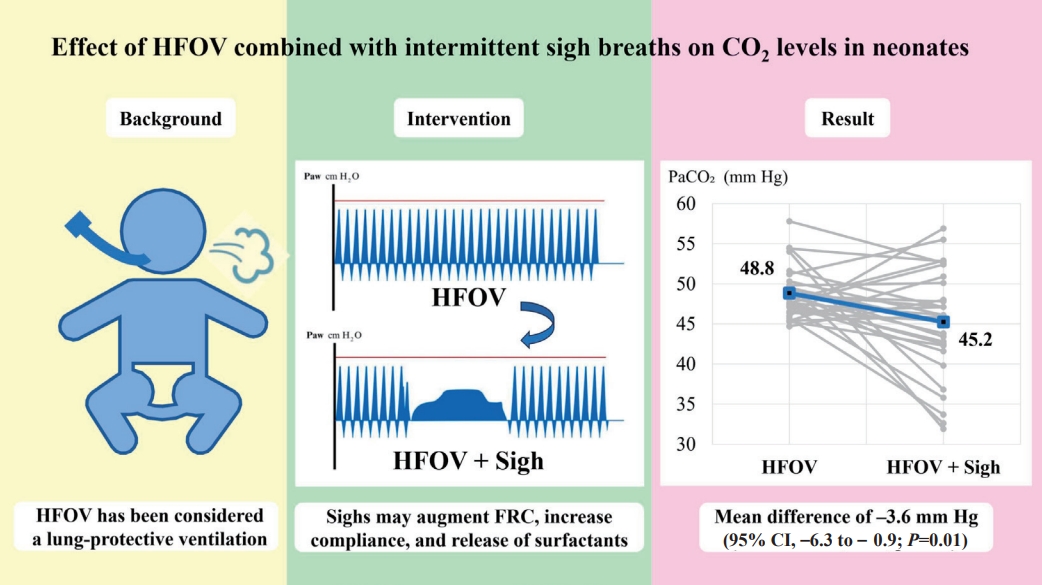
Question: Can sigh breaths (Sighs) application during high-frequency oscillatory ventilation (HFOV) decrease partial pressure of carbon dioxide (PaCO2) levels?
Finding: The mean PaCO2 level after Sighs during HFOV was significantly decreased compared to that after HFOV alone (mean difference, -3.6 mmHg).
Meaning: HFOV plus Sighs functionality can reduce PaCO2 levels. However, further studies are required to conclusively determine the effects of Sighs.
- Review Article
- Neonatology (Perinatology)
- Need for national guidance regarding proactive care of infants born at 22–23 weeks' gestation
- Ga Won Jeon
- Clin Exp Pediatr. 2025;68(1):53-61. Published online November 13, 2024
-

With advancements in neonatal intensive care, the limit of viability has shifted to 22–23 weeks' gestation, whose survival rates vary across countries and institutions. These rates are not static and can be improved through the proactive and centralized care guided by national protocols, including maternal transfer to high-activity regions with better neonatal intensive care practices before delivery.
- Strategies to support language development in neonatal intensive care unit: a narrative review
- Ju Sun Heo, Ee-Kyung Kim
- Clin Exp Pediatr. 2024;67(12):651-663. Published online November 6, 2024
-
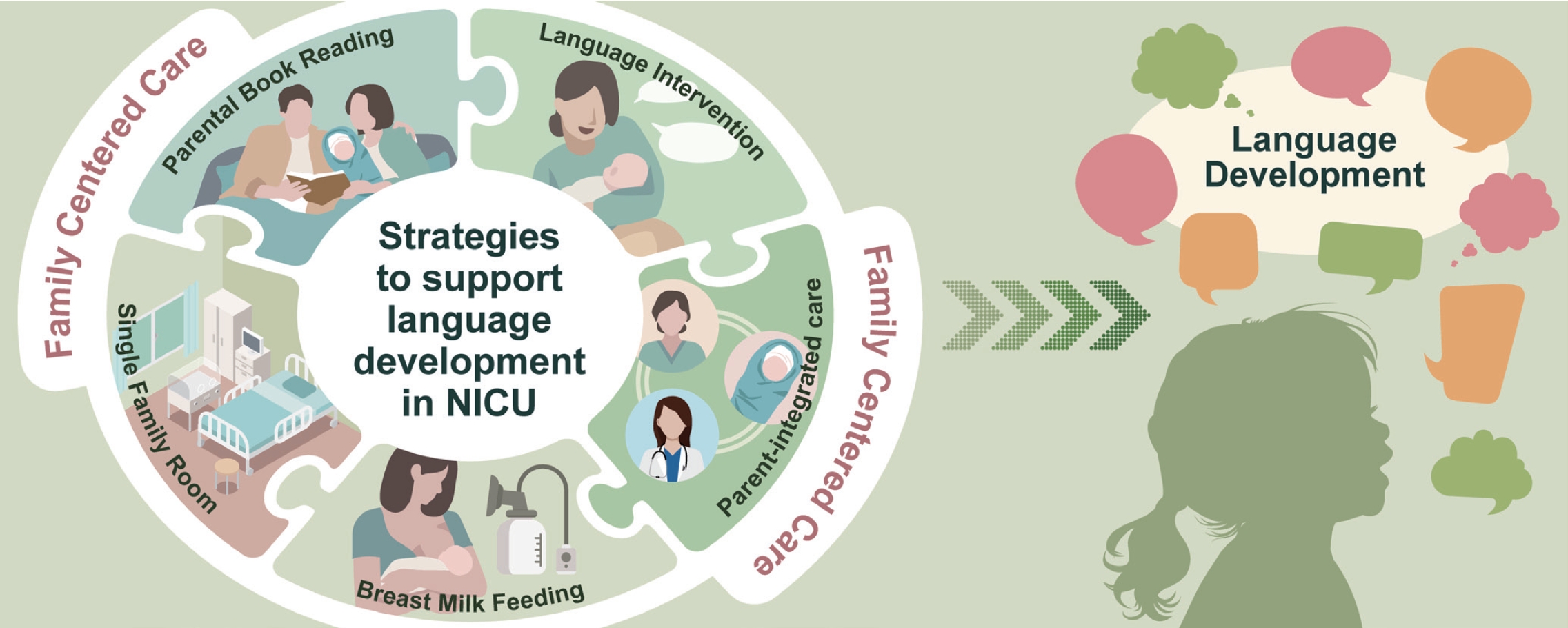
· Preterm infants often experience speech and language development delays during early childhood, impacting children's ultimate outcomes.
· Promoting breastfeeding, increasing parent-infant interactions in a single-family room, promoting a nurturing language environment by parental book reading and language interventions, and parent-integrated interventions in the neonatal intensive care unit could potentially enhance children's language development.
· Integrating these strategies through family-centered care is essential.
- Original Article
- Neonatology (Perinatology)
- Mortality of very low birth weight infants by neonatal intensive care unit workload and regional group status
- Sung-Hoon Chung, Chae Young Kim, Yong-Sung Choi, Myung Hee Lee, Jae Woo Lim, Byong Sop Lee, Ki-Soo Kim; the Korean Neonatal Network
- Clin Exp Pediatr. 2024;67(11):619-627. Published online September 12, 2024
-

Question: How do structural and staffing characteristics of neonatal intensive care units (NICUs) influence the mortality rates of very low birth weight infants (VLBWIs)?
Findings: NICUs with higher staffing levels, particularly with more neonatologists, and those offering advanced care levels were associated with lower mortality rates. Additionally, regional disparities were observed, with some areas demon-strating significantly higher survival rates.
Meaning: Adequate staffing and equitable regional distribution of medical resources are crucial for improving survival outcomes in VLBWIs. Efforts to enhance NICU staffing and address regional healthcare disparities are essential for optimizing care quality and reducing mortality in this vulnerable population.
- Developmental and Behavioral Medicine
- Neonatal risk factors associated with autism spectrum disorders: an umbrella review
- Amir Mohammad Salehi, Erfan Ayubi, Salman Khazaei, Ensiyeh Jenabi, Saeid Bashirian, Zohreh Salimi
- Clin Exp Pediatr. 2024;67(9):459-464. Published online July 19, 2024
-

Question: What are the neonatal risk factors for autism spectrum disorder (ASD)?
Findings: Significant effect sizes were observed for congenital heart disease (odds ratio [OR], 1.35), macrosomia (OR, 1.11), low birth weight (OR, 1.63), very low birth weight (OR, 2.25), small for gestational age (OR, 1.17), jaundice (OR, 1.74), male sex (OR, 1.47), and Apgar score (OR, 1.40).
Meaning: These factors were identified as risk factors for ASD.
- Neonatology (Perinatology)
- Prevalence of anxiety, depression, and stress among parents of neonates admitted to neonatal intensive care unit: a systematic review and meta-analysis
- Asha P. Shetty, Kurvatteppa Halemani, Alwin Issac, Latha Thimmappa, Sanjay Dhiraaj, Radha K, Prabhaker Mishra, Vijai Datta Upadhyaya
- Clin Exp Pediatr. 2024;67(2):104-115. Published online November 14, 2023
-
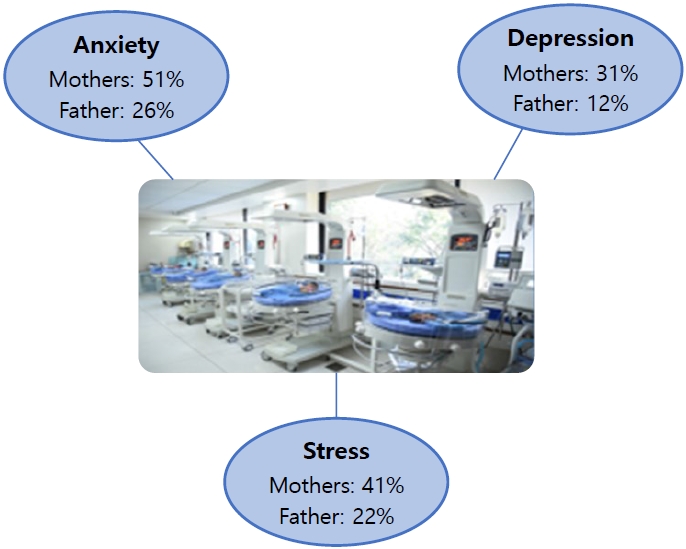
Question: What emotions do parents experience when their newborns are admitted to the neonatal intensive care unit (NICU)?
Finding: Mothers experienced more anxiety (51%), depression (31%), and stress (41%) symptoms than fathers (26%, 12%, and 22%, respectively).
Meaning: Parents often experience anxiety, stress, and depression following NICU admission. Healthcare workers are responsible for providing regular parental counseling.
- Developmental and Behavioral Medicine
- Neonatal risk factors associated with attention-deficit/hyperactivity disorder: an umbrella review
- Ensiyeh Jenabi, Erfan Ayubi, Sajjad Farashi, Saeid Bashirian, Fereshteh Mehri
- Clin Exp Pediatr. 2023;66(10):441-446. Published online July 14, 2023
-
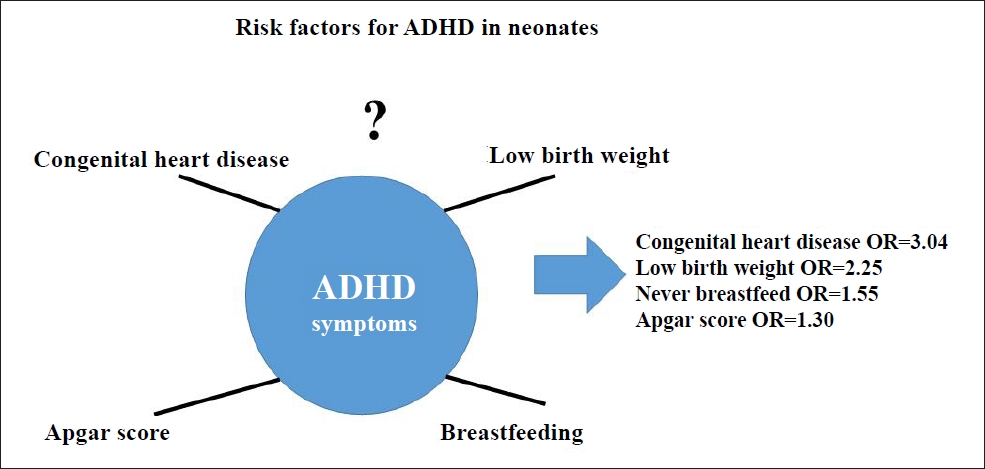
Question: The risk factors for attention deficit hyperactivity disorder (ADHD), such as breastfeeding, congenital heart disease, and low birth weight, in neonates are not well understood.
Finding: This umbrella review obtained significant effect sizes for ADHD for congenital heart disease (odds ratio [OR], 3.04), low birth weight (OR, 2.25), never breastfed (OR, 1.55), and Apgar score (OR, 1.30).
Meaning: Congenital heart disease, low birth weight, lack of breastfeeding, and Apgar scores were significant factors for ADHD.
- Review Article
- Neonatology (Perinatology)
- Neonatal family-centered care: evidence and practice models
- Juyoung Lee
- Clin Exp Pediatr. 2024;67(4):171-177. Published online June 14, 2023
-
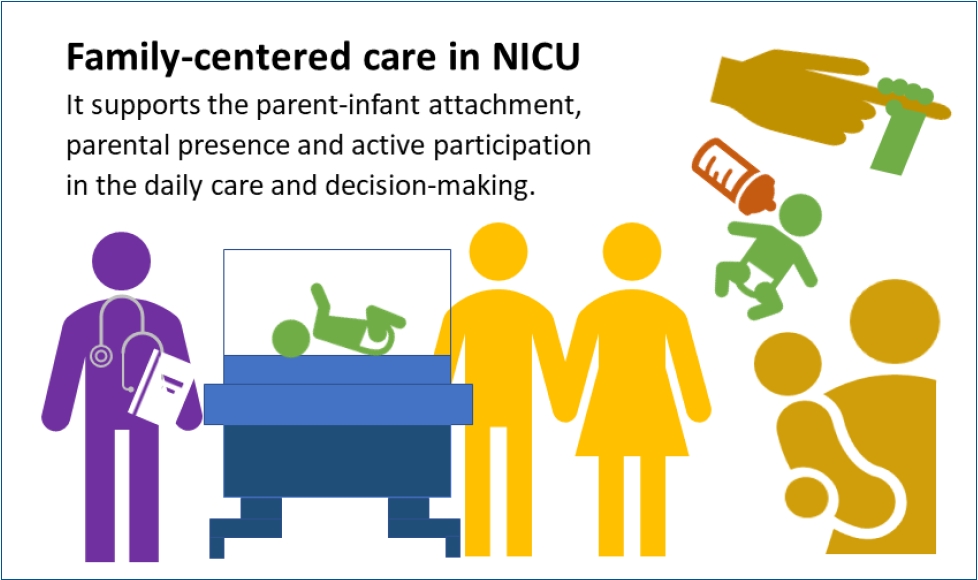
· Concrete evidence exists of early parent-infant attachment supported by family-centered care (FCC) in the neonatal intensive care unit.
· FCC involves the parents’ presence and participation in the infant’s care and decision-making.
· A private and comfortable space should be provided. A single-family room is ideal; however, a quiet space with a recliner can be a good alternative.
· Care culture changes and staff training are required.
- Neurology
- Neonatal seizures: diagnostic updates based on new definition and classification
- Eun-Hee Kim, Jeongmin Shin, Byoung Kook Lee
- Clin Exp Pediatr. 2022;65(8):387-397. Published online April 4, 2022
-
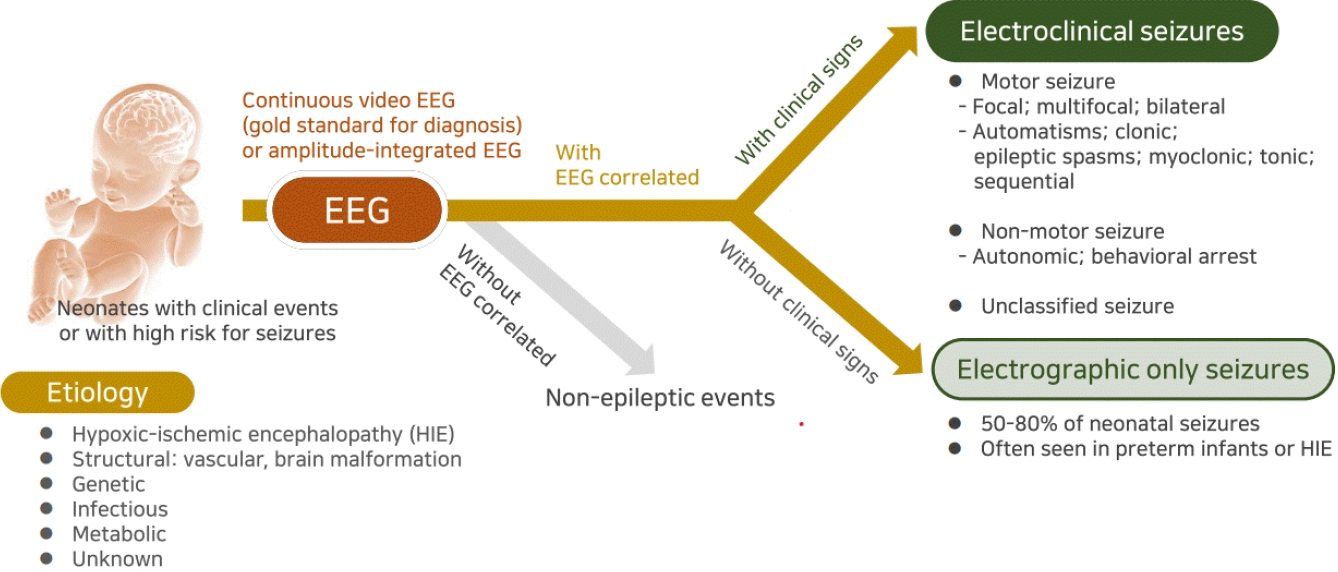
· Neonatal seizures are often electrographic-only seizures without clinical signs; therefore, the identification of electrical seizure activity on electroencephalography is the gold standard for diagnosis.
· Clinical signs of neonatal seizures are divided into motor or nonmotor seizures, and motor seizures are mostly focal or multifocal.
· Most neonatal seizures are caused by acute symptomatic etiologies, but in cases of intractable seizures, structural, genetic, or metabolic etiologies should be investigated.
- Original Article
- Neonatology (Perinatology)
- Neonatal sepsis-causing bacterial pathogens and outcome of trends of their antimicrobial susceptibility a 20-year period at a neonatal intensive care unit
- Woo Sun Song, Hye Won Park, Moon Youn Oh, Jae Young Jo, Chae Young Kim, Jung Ju Lee, Euiseok Jung, Byong Sop Lee, Ki-Soo Kim, Ellen Ai-Rhan Kim
- Clin Exp Pediatr. 2022;65(7):350-357. Published online December 9, 2021
-
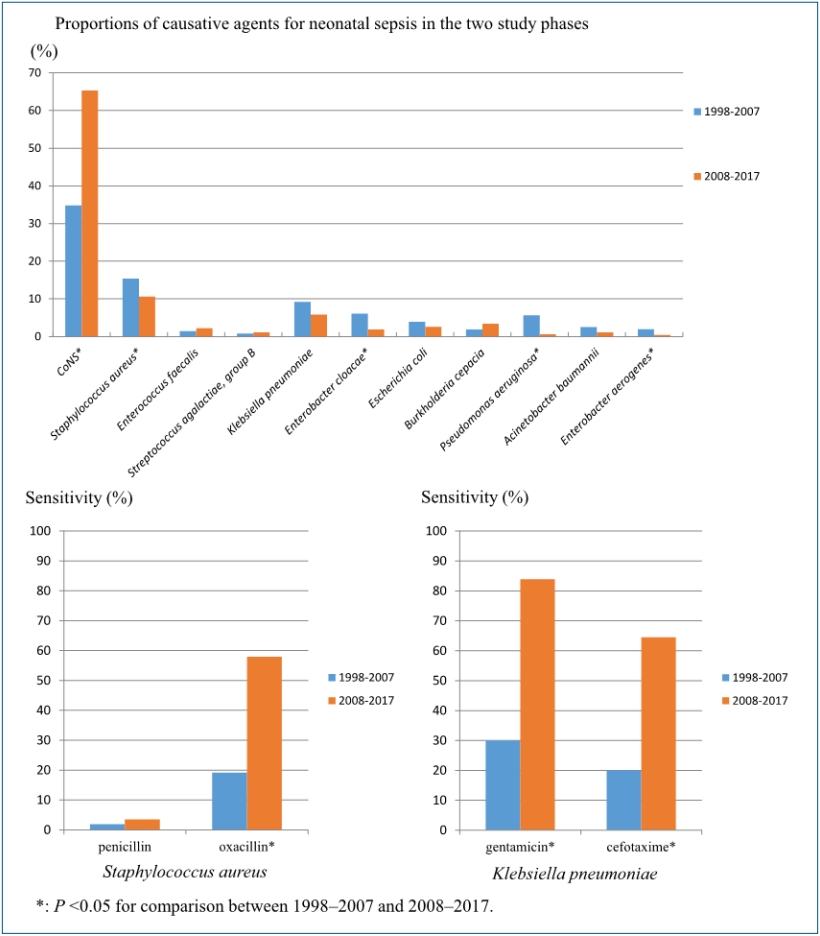
Question: What is prevalence of bacterial pathogens causing sepsis and their antimicrobial susceptibility over 20 years?
Finding: Coagulase-negative remains most common causative organism. The most common gram-negative organism was Klebsiella pneumonia. The susceptibility of staphylococcus aureus and K. pneumonia showed increased susceptability to oxacillin, cefotaxime and amikacin, gentamicin, respectively.
Meaning: Answers to the question asked is important in choosing antimicrobials and to monitor emergence of multidrug-resistant organisms.
- Review Article
- Neurology
- Cognitive outcomes in late childhood and adolescence of neonatal hypoxic-ischemic encephalopathy
- Bo Lyun Lee, Hannah C. Glass
- Clin Exp Pediatr. 2021;64(12):608-618. Published online May 24, 2021
-
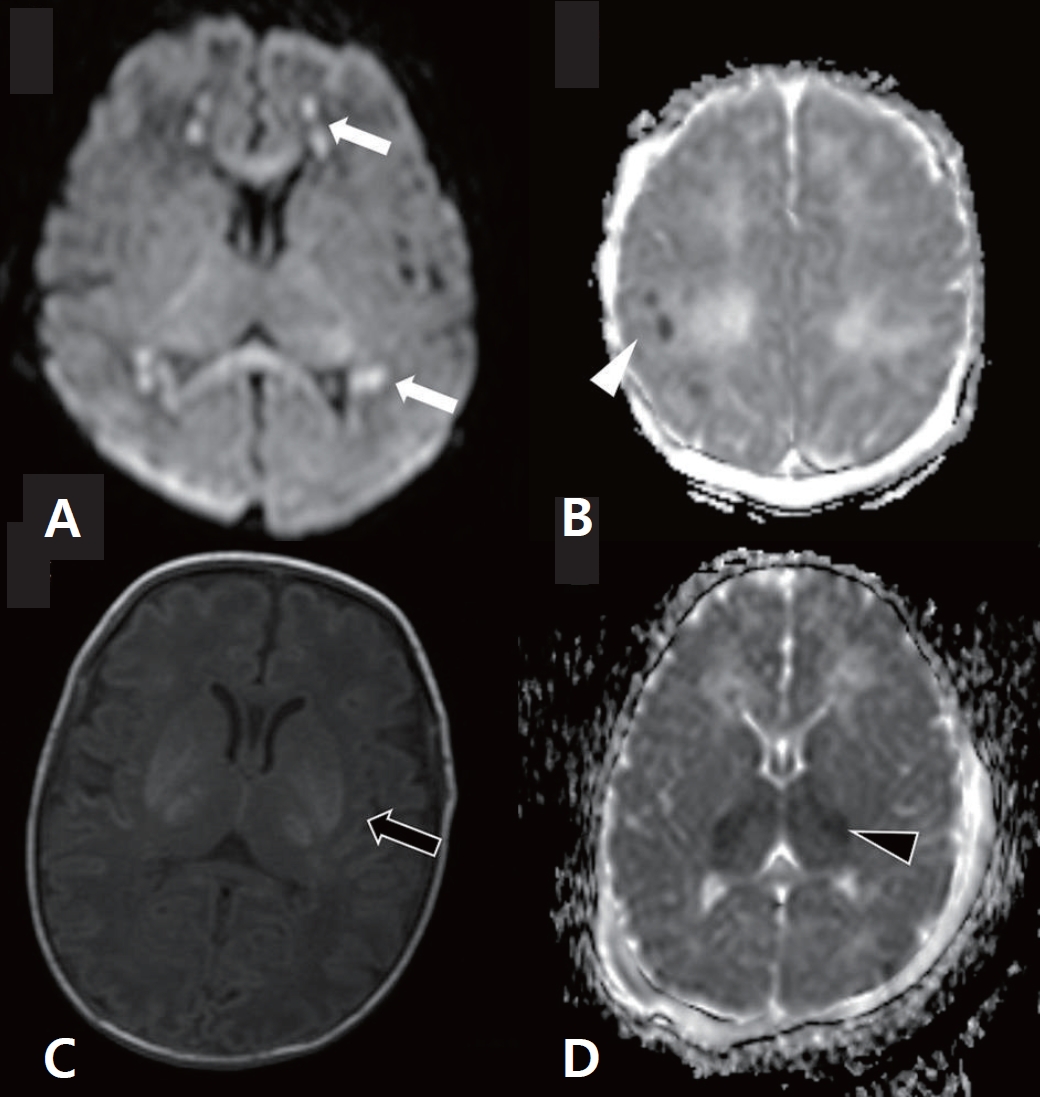
∙ Cognitive impairments occur in children with hypoxic-ischemic encephalopathy (HIE) even without neuromotor deficits.
∙ Therapeutic hypothermia has improved neurodevelopmental outcomes of children with HIE; however, 40% of children remain at risk of death/disability or cognitive impairments necessitating the development of adjunctive neuroprotective therapies.
∙ Long-term follow-up until adolescence is required to identify cognitive dysfunction.
∙ A pattern of watershed injury on brain imaging is associated with poor cognitive outcomes.
- Immunology
- Modern diagnostic capabilities of neonatal screening for primary immunodeficiencies in newborns
- Evgenia Olegovna Khalturina, Natalia Dmitrievna Degtyareva, Anastasiia Vasi’evna Bairashevskaia, Alena Valerievna Mulenkova, Anna Vladimirovna Degtyareva
- Clin Exp Pediatr. 2021;64(10):504-510. Published online March 25, 2021
-
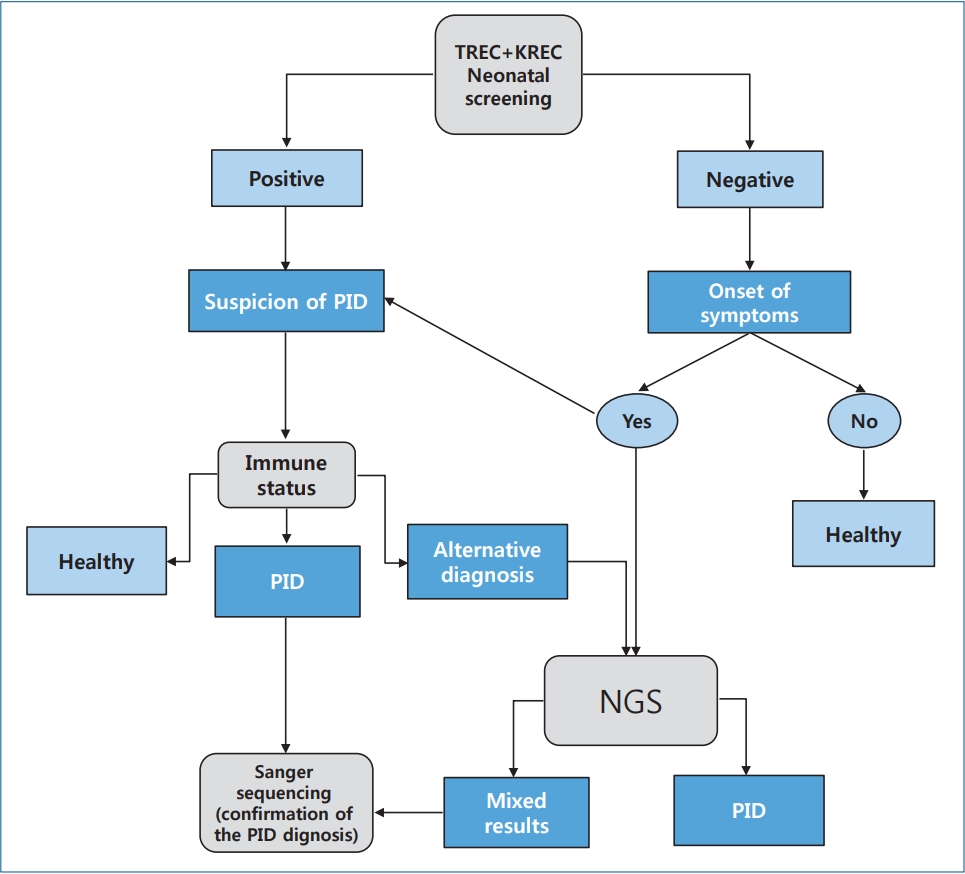
· Neonatal screening for primary immunodeficiency diseases (PIDs) enables early diagnosis and subsequent initiation of therapy.
· Excision of T-cell receptors and kappa-recombination excision circles are cheaper alternative PID screening methods.
· Sanger DNA sequencing remains the reference method for detecting PID; however, next-generation sequencing technology is increasingly used to diagnose it.
· Here we developed a graphical algorithm for diagnosing primary immunodeficiency syndrome based on modern methods of screening for primary immunodeficiencies in newborns.
- Original Article
- Neonatology (Perinatology)
- Perinatal outcome and possible vertical transmission of coronavirus disease 2019: experience from North India
- Ritu Sharma, Shikha Seth, Rakhee Sharma, Sanju Yadav, Pinky Mishra, Sujaya Mukhopadhyay
- Clin Exp Pediatr. 2021;64(5):239-246. Published online February 16, 2021
-

Question: Is there any risk of vertical transmission of coronavirus disease 2019 (COVID-19), and what is its neonatal profile?
Finding: Biological samples for vertical transmission were negative in all deliveries; however, 2 neonates tested positive for nasopharyngeal COVID-19 reverse transcription-polymerase chain reaction. No significant neonatal morbidity was observed.
Meaning: COVID-19 does not increase adverse neonatal outcomes and shows a negligible risk of vertical transmission; however, horizontal transmission cannot be underestimated.
- Other
- Evaluation of goodness of fit of semiparametric and parametric models in analysis of factors associated with length of stay in neonatal intensive care unit
- Fatemeh Kheiry, Sadegh Kargarian-Marvasti, Sima Afrashteh, Abolfazl Mohammadbeigi, Nima Daneshi, Salma Naderi, Seyed Hossein Saadat
- Clin Exp Pediatr. 2020;63(9):361-367. Published online June 10, 2020
-

Question: Hospitalization in neonatal intensive care unit (NICU) is associated with life-threatening hazards. What factors associated with neonatal length of stay (LOS) in the NICU?
Finding: Breastfeeding, phototherapy, acute renal failure (ARF), mechanical ventilation, and central venous catheter (CVC) access were identified as factors associated with NICU length of stay.
Meaning: Protective effects of breastfeeding and CVC access, whereas increase effects of phototherapy, ARF, and mechanical ventilation in LOS can be supporting evidence to establish effective interventions to reduce length of NICU stay.
- Neonatology (Perinatology)
- Risk-based maternal group B Streptococcus screening strategy is compatible with the implementation of neonatal early-onset sepsis calculator
- Niek B. Achten, J. Wendelien Dorigo-Zetsma, Annemarie M.C. van Rossum, Rianne Oostenbrink, Frans B. Plötz
- Clin Exp Pediatr. 2020;63(10):406-410. Published online April 16, 2020
-
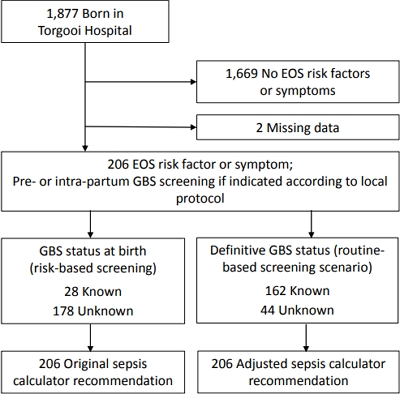
Question: To what extent does risk-based Group B Streptococcus (GBS) screening influence management recommendations by the early-onset sepsis (EOS) calculator?
Finding: In 97% of the newborn infants, the EOS calculator recommendation remained unchanged after the GBS status at birth was updated to the definitive GBS status.
Meaning: Risk-based GBS screening results are compatible with EOS calculator recommendations.
- Review Article
- Neonatology (Perinatology)
- Short- and long-term outcomes of very low birth weight infants in Korea: Korean Neonatal Network update in 2019
- Jang Hoon Lee, YoungAh Youn, Yun Sil Chang; Korean Neonatal Network
- Clin Exp Pediatr. 2020;63(8):284-290. Published online February 5, 2020
-

The Korean Neonatal Network (KNN) has collected population-based data for very low birth weight infants (VLBWIs) born in Korea since 2013. The survival rate of all VLBWIs was 86% in Korea. The overall prevalence of cerebral palsy was 6.2%–6.6%. Bilateral blindness and hearing loss were reported in 0.2%–0.3%, 0.8%–1.9%, respectively. The KNN has published annual reports and papers for facilitating the improvement of VLBWIs outcome in Korea.
- Systematic review and meta-analysis
- Neurobehavior
- Association between neonatal jaundice and autism spectrum disorders among children: a meta-analysis
- Ensiyeh Jenabi, Saeid Bashirian, Salman Khazaei
- Clin Exp Pediatr. 2020;63(1):8-13. Published online November 7, 2019
-
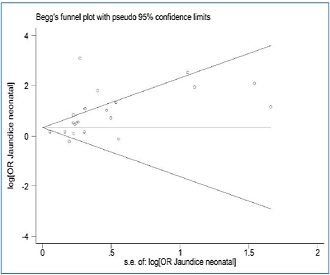
Autism spectrum disorder is a common neurodevelopmental disorder with an unknown etiology. The correlation between neonatal jaundice and the risk of developing autism spectrum disorder was investigated previously. Some studies showed significant associations, whereas others demonstrated no association. In this meta-analysis, we pooled the results of observational studies to examine the association between neonatal jaundice and the risk of autism...
- Original Article
- Neonatology (Perinatology)
- Diagnostic value of eosinopenia and neutrophil to lymphocyte ratio on early onset neonatal sepsis
- Rocky Wilar
- Clin Exp Pediatr. 2019;62(6):217-223. Published online October 8, 2018
-
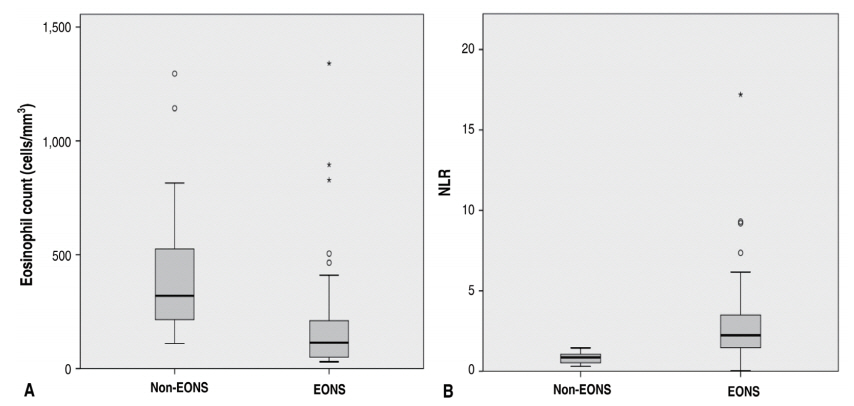
Purpose: To determine the diagnostic value of eosinopenia and the neutrophil-to-lymphocyte ratio (NLR) in the diagnosis of early onset neonatal sepsis (EONS). Methods: This cross-sectional study was conducted in the Neonatology Ward of R.D. Kandou General Hospital Manado between July and October 2017. Samples were obtained from all neonates meeting the inclusion criteria for EONS. Data were encoded using logistic regression...
- Clinical features and prognostic factors of early-onset sepsis: a 7.5-year experience in one neonatal intensive care unit
- Se Jin Kim, Ga Eun Kim, Jae Hyun Park, Sang Lak Lee, Chun Soo Kim
- Clin Exp Pediatr. 2019;62(1):36-41. Published online September 27, 2018
-
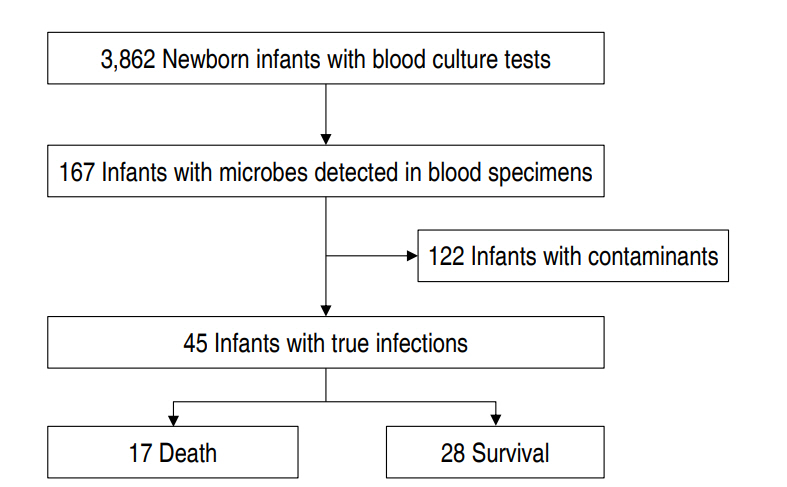
Purpose: In this study, we investigated the clinical features and prognostic factors of early-onset sepsis (EOS) in neonatal intensive care unit (NICU) patients. Methods: A retrospective analysis was conducted on medical records from January 2010 to June 2017 (7.5 years) of a university hospital NICU. Results: There were 45 cases of EOS (1.2%) in 3,862 infants. The most common pathogen responsible for...
- Genetics and Metabolism
- Neonatal indirect hyperbilirubinemia and glucose-6-phosphate dehydrogenase deficiency
- Hasan M. Isa, Masooma S. Mohamed, Afaf M. Mohamed, Adel Abdulla, Fuad Abdulla
- Clin Exp Pediatr. 2017;60(4):106-111. Published online April 25, 2017
-
Purpose This study aimed to determine the prevalence of glucose-6-phosphate dehydrogenase (G6PD) deficiency among infants with neonatal indirect hyperbilirubinemia (NIH); compare G6PD-deficient and G6PD-normal patients regarding hyperbilirubinemia and need for exchange transfusions (ET); and assess risk factors for ET and kernicterus.
Methods This is a case-control retrospective study. Medical records of NIH patients admitted to the Pediatric Department, Salmaniya Medical Complex, Bahrain, between...
- Neonatology (Perinatology)
- Experience and pharmacokinetics of Levetiracetam in Korean neonates with neonatal seizures
- Jae Won Shin, Yun Seob Jung, Kyungsoo Park, Soon Min Lee, Ho Seon Eun, Min Soo Park, Kook In Park, Ran Namgung
- Clin Exp Pediatr. 2017;60(2):50-54. Published online February 27, 2017
-

Purpose The aims of this study were to evaluate the safety and pharmacokinetics of levetiracetam (LEV) in neonates with seizures and to establish a population pharmacokinetics (PPK) model by using the software NONMEM.
Methods A retrospective analysis of 18 neonatal patients with seizures, who were treated with LEV, including 151 serum samples, was performed. The mean loading dose was 20 mg/kg, followed by...
- Case Report
- Genetics and Metabolism
- Compound heterozygous mutations of
ACADS gene in newborn with short chain acyl-CoA dehydrogenase deficiency: case report and literatures review - Se Jin An, Sook Za Kim, Gu Hwan Kim, Han Wook Yoo, Han Hyuk Lim
- Clin Exp Pediatr. 2016;59(Suppl 1):S45-S48. Published online November 30, 2016
-
Short-chain acyl-CoA dehydrogenase deficiency (SCADD) is a rare autosomal recessive mitochondrial disorder of fatty acid β-oxidation, and is associated with mutations in the acyl-CoA dehydrogenase (
ACADS ) gene. Recent advances in spectrometric screening for inborn errors of metabolism have helped detect several metabolic disorders, including SCADD, without symptoms in the neonate period. This allows immediate initiation of treatment and monitoring, so...
- Successful sulfonylurea treatment in a patient with permanent neonatal diabetes mellitus with a novel
KCNJ11 mutation - Sung Yeon Ahn, Gu-Hwan Kim, Han-Wook Yoo
- Clin Exp Pediatr. 2015;58(8):309-312. Published online August 21, 2015
-
Permanent neonatal diabetes mellitus refers to diabetes that occurs before the age of 6 months and persists through life. It is a rare disorder affecting one in 0.2-0.5 million live births. Mutations in the gene
KCNJ11 , encoding the subunit Kir6.2, and ABCC8, encoding SUR1 of the ATP-sensitive potassium (KATP) channel, are the most common causes of permanent neonatal diabetes mellitus....
- Original Article
- Thyroid dysfunction in very low birth weight preterm infants
- Ji Hoon Lee, Sung Woo Kim, Ga Won Jeon, Jong Beom Sin
- Clin Exp Pediatr. 2015;58(6):224-229. Published online June 22, 2015
-
Purpose Thyroid dysfunction is common in preterm infants. Congenital hypothyroidism causes neurodevelopmental impairment, which is preventable if properly treated. This study was conducted to describe the characteristics of thyroid dysfunction in very low birth weight infants (VLBWIs), evaluate risk factors of hypothyroidism, and suggest the reassessment of thyroid function with an initially normal thyroid-stimulating hormone (TSH) as part of a newborn...
- Case Report
- Asymptomatic maternal 3-methylcrotonylglycinuria detected by her unaffected baby's neonatal screening test
- Sun Hee Lee, Yong Hee Hong
- Clin Exp Pediatr. 2014;57(7):329-332. Published online July 23, 2014
-
3-methylcrotonyl-coenzyme A carboxylase (3MCC) deficiency is an autosomal recessive disorder in which leucine catabolism is hampered, leading to increased urinary excretion of 3-methylcrotonylglycine. In addition, 3-hydroxyisovalerylcarnitine levels increase in the blood, and the elevated levels form the basis of neonatal screening. 3MCC deficiency symptoms are variable, ranging from neonatal onset with severe neurological abnormality to a normal, asymptomatic phenotype. Although...
-

-
-
8.02023CiteScore94th percentilePowered by
-
Impact Factor3.2
-
- TOPICS
- ARTICLE CATEGORY
- Editorial Office
-
Korean Pediatric Society
#1606 Seocho World Officetel, 19 Seoun-ro, Seocho-ku, Seoul 06732, Korea
Tel: +82-2-3473-7306 Fax: +82-2-3473-7307 E-mail: office@e-cep.org
Clinical and Experimental Pediatrics is an open access journal. All articles are distributed under the terms of the Creative Commons Attribution NonCommercial License (http://creativecommons.org/licenses/by-nc/4.0/)
Copyright © 2025 by Korean Pediatric Society.











